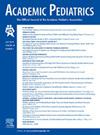儿童接触暴力内容和攻击性:一个古老争论的新方法。
IF 2.8
3区 医学
Q1 PEDIATRICS
引用次数: 0
摘要
目的:我们的目的是研究儿童早期接触暴力内容与男孩和女孩的反应性和主动性攻击发展之间的双向、个人关系。方法:数据来自加拿大魁北克的975名女孩和987名男孩,并在魁北克儿童发展纵向研究(QLSCD;1998 - 2023)。家长报告说,孩子在4岁、5岁和6岁时接触暴力电视内容以及主动和被动攻击。数据分析采用随机截距交叉滞后面板模型。结果:4岁时接触更多暴力内容与5岁时男孩(β = 0.16, 95% CI =[.050,.261])和女孩(β = 0.13, CI =[.004,.229])的人身内反应性攻击增加有关。此外,4岁时更大的主动攻击与5岁时男孩接触暴力内容的减少有关(β = -0.08, 95% CI =[-])。[174, - 0.003])和女孩(β = -。09, 95% ci =[-]。174年,-.009])。在5至6岁的男孩和女孩中也观察到类似的模式(β = -0.08, 95% CI =[-])。167年-。[03]男孩和β = -。10、95% ci =[-]。194年-。[10]女孩)。结论:我们的研究结果表明,儿童早期接触暴力内容与反应性攻击的发展呈正相关。更大的儿童主动攻击也与减少接触暴力内容有关,这表明父母在监控儿童的媒体习惯时可能采取反应性方法,而不是预防性方法。本文章由计算机程序翻译,如有差异,请以英文原文为准。
Child Exposure to Violent Content and Aggression: A Novel Approach to an Old Debate
Objective
Our objective is to examine bidirectional, within-person associations between early childhood exposure to violent content in boys and girls and the development of reactive and proactive aggression.
Methods
Data are from 975 girls and 987 boys from Quebec, Canada, followed in the context of the Quebec Longitudinal Study of Child Development (1998–2023). Parents reported child exposure to violent TV content and proactive and reactive aggression at ages 4 to 6. Data were analyzed using random-intercept cross-lagged panel models.
Results
Greater exposure to violent content at ages 4 was associated with within-person increases in reactive aggression by age 5 in boys (β = 0.16, 95% Confidence Interval = [0.050, 0.261]) and girls (β = 0.13, CI = [0.004, 0.229]). In addition, greater proactive aggression at age 4 was associated with a within-person decrease in exposure to violent content by age 5 in boys (β = −0.08, 95% CI = [−0.174, −0.003]) and girls (β = −0.09, 95% CI = [−0.174, −0.009]). A similar pattern was observed for boys and girls between the ages of 5 and 6 (β = −0.08, 95% CI = [−0.167, −0.003] for boys and β = −0.10, 95% CI = [−0.194, −0.010] for girls).
Conclusions
Our findings suggest a positive association between early childhood exposure to violent content and the development of reactive aggression. Greater child proactive aggression was also associated with reduced exposure to violent content, suggesting that parents may adopt a reactive, rather than preventive approach when monitoring child media habits.
求助全文
通过发布文献求助,成功后即可免费获取论文全文。
去求助
来源期刊

Academic Pediatrics
PEDIATRICS-
CiteScore
4.60
自引率
12.90%
发文量
300
审稿时长
60 days
期刊介绍:
Academic Pediatrics, the official journal of the Academic Pediatric Association, is a peer-reviewed publication whose purpose is to strengthen the research and educational base of academic general pediatrics. The journal provides leadership in pediatric education, research, patient care and advocacy. Content areas include pediatric education, emergency medicine, injury, abuse, behavioral pediatrics, holistic medicine, child health services and health policy,and the environment. The journal provides an active forum for the presentation of pediatric educational research in diverse settings, involving medical students, residents, fellows, and practicing professionals. The journal also emphasizes important research relating to the quality of child health care, health care policy, and the organization of child health services. It also includes systematic reviews of primary care interventions and important methodologic papers to aid research in child health and education.
 求助内容:
求助内容: 应助结果提醒方式:
应助结果提醒方式:


